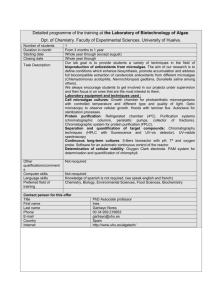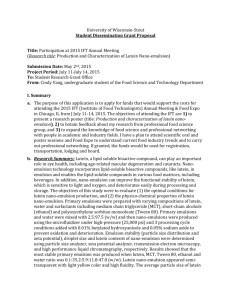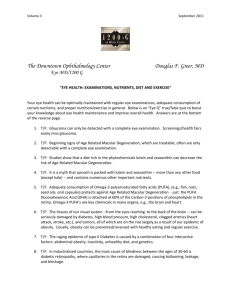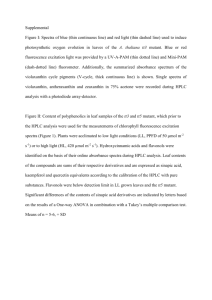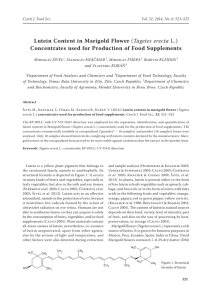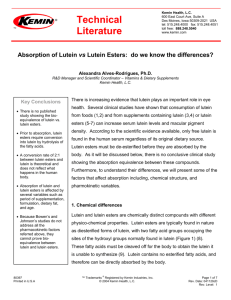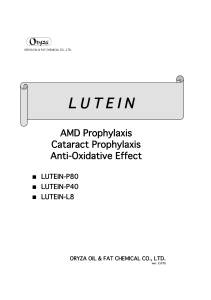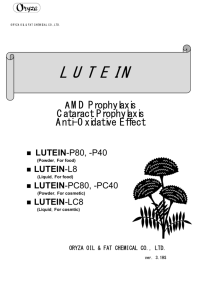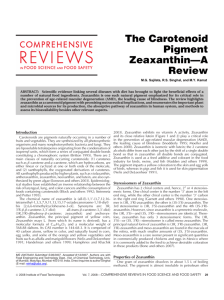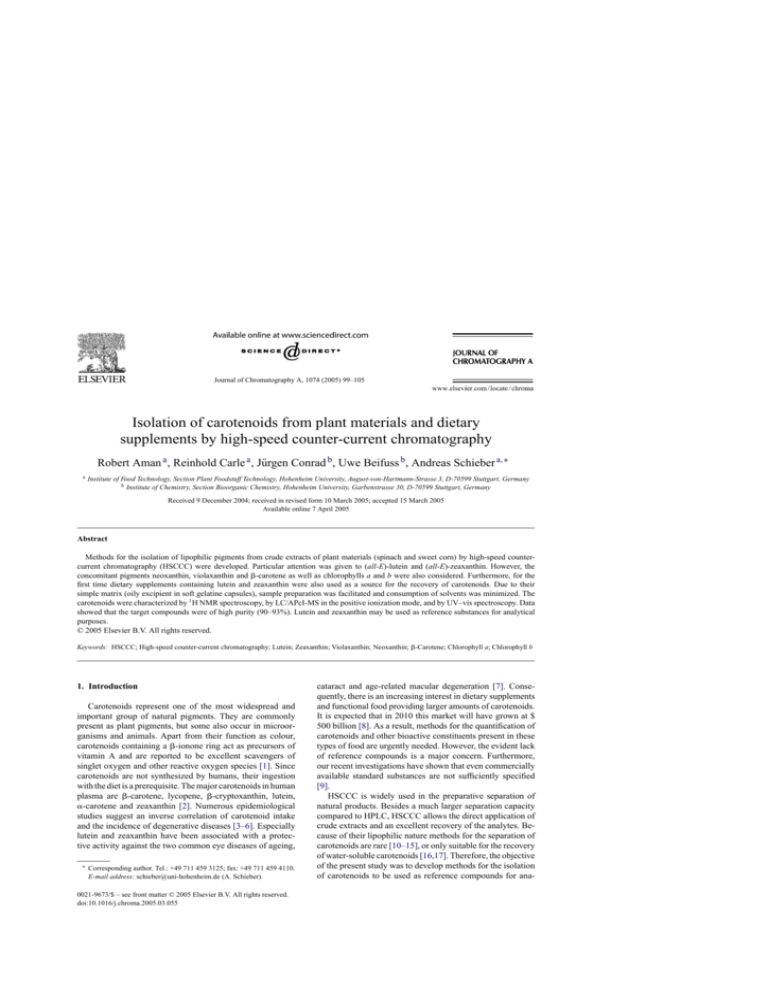
Journal of Chromatography A, 1074 (2005) 99–105
Isolation of carotenoids from plant materials and dietary
supplements by high-speed counter-current chromatography
Robert Aman a , Reinhold Carle a , Jürgen Conrad b , Uwe Beifuss b , Andreas Schieber a,∗
a
Institute of Food Technology, Section Plant Foodstuff Technology, Hohenheim University, August-von-Hartmann-Strasse 3, D-70599 Stuttgart, Germany
b Institute of Chemistry, Section Bioorganic Chemistry, Hohenheim University, Garbenstrasse 30, D-70599 Stuttgart, Germany
Received 9 December 2004; received in revised form 10 March 2005; accepted 15 March 2005
Available online 7 April 2005
Abstract
Methods for the isolation of lipophilic pigments from crude extracts of plant materials (spinach and sweet corn) by high-speed countercurrent chromatography (HSCCC) were developed. Particular attention was given to (all-E)-lutein and (all-E)-zeaxanthin. However, the
concomitant pigments neoxanthin, violaxanthin and -carotene as well as chlorophylls a and b were also considered. Furthermore, for the
first time dietary supplements containing lutein and zeaxanthin were also used as a source for the recovery of carotenoids. Due to their
simple matrix (oily excipient in soft gelatine capsules), sample preparation was facilitated and consumption of solvents was minimized. The
carotenoids were characterized by 1 H NMR spectroscopy, by LC/APcI-MS in the positive ionization mode, and by UV–vis spectroscopy. Data
showed that the target compounds were of high purity (90–93%). Lutein and zeaxanthin may be used as reference substances for analytical
purposes.
© 2005 Elsevier B.V. All rights reserved.
Keywords: HSCCC; High-speed counter-current chromatography; Lutein; Zeaxanthin; Violaxanthin; Neoxanthin; -Carotene; Chlorophyll a; Chlorophyll b
1. Introduction
Carotenoids represent one of the most widespread and
important group of natural pigments. They are commonly
present as plant pigments, but some also occur in microorganisms and animals. Apart from their function as colour,
carotenoids containing a -ionone ring act as precursors of
vitamin A and are reported to be excellent scavengers of
singlet oxygen and other reactive oxygen species [1]. Since
carotenoids are not synthesized by humans, their ingestion
with the diet is a prerequisite. The major carotenoids in human
plasma are -carotene, lycopene, -cryptoxanthin, lutein,
␣-carotene and zeaxanthin [2]. Numerous epidemiological
studies suggest an inverse correlation of carotenoid intake
and the incidence of degenerative diseases [3–6]. Especially
lutein and zeaxanthin have been associated with a protective activity against the two common eye diseases of ageing,
∗
Corresponding author. Tel.: +49 711 459 3125; fax: +49 711 459 4110.
E-mail address: schieber@uni-hohenheim.de (A. Schieber).
0021-9673/$ – see front matter © 2005 Elsevier B.V. All rights reserved.
doi:10.1016/j.chroma.2005.03.055
cataract and age-related macular degeneration [7]. Consequently, there is an increasing interest in dietary supplements
and functional food providing larger amounts of carotenoids.
It is expected that in 2010 this market will have grown at $
500 billion [8]. As a result, methods for the quantification of
carotenoids and other bioactive constituents present in these
types of food are urgently needed. However, the evident lack
of reference compounds is a major concern. Furthermore,
our recent investigations have shown that even commercially
available standard substances are not sufficiently specified
[9].
HSCCC is widely used in the preparative separation of
natural products. Besides a much larger separation capacity
compared to HPLC, HSCCC allows the direct application of
crude extracts and an excellent recovery of the analytes. Because of their lipophilic nature methods for the separation of
carotenoids are rare [10–15], or only suitable for the recovery
of water-soluble carotenoids [16,17]. Therefore, the objective
of the present study was to develop methods for the isolation
of carotenoids to be used as reference compounds for ana-
100
R. Aman et al. / J. Chromatogr. A 1074 (2005) 99–105
Dassel, Germany) to remove particles. Organic solvents were
evaporated in vacuo (T < 30 ◦ C). The residue was dissolved
in 300 ml of hexane and washed three times with 900 ml
of water to remove water-soluble compounds (e.g. sugars,
starch and protein). Organic solvents were evaporated in
vacuo (T < 30 ◦ C), and the dried residues were stored under
nitrogen at −80 ◦ C. Portions thereof were used for HSCCC.
Fig. 1. Structures of (all-E)-lutein and (all-E)-zeaxanthin.
lytical purposes. Owing to their relevance as constituents of
dietary supplements, particular attention was given to (allE)-lutein and (all-E)-zeaxanthin (Fig. 1). Because the xanthophylls were isolated from spinach and sweet corn, the
concomitant pigments violaxanthin, neoxanthin, -carotene
and chlorophylls a and b of spinach were also included in the
study. Furthermore, the utilization of dietary supplements as
source for carotenoids is reported for the first time. For environmental and health protection, the use of halogenated
hydrocarbons was avoided.
2. Experimental
2.1. Materials
All chemicals used were purchased from VWR (Darmstadt, Germany) and were of reagent grade. HPLC solvents
were of gradient grade. For HPLC analyses and sample preparations ultrapure water was employed. (All-E)-lutein and (allE)-zeaxanthin were supplied by Hoffmann-La Roche (Basel,
Switzerland). Spinach (Spinacia oleracea L.) and sweet corn
(Zea mays L.) were purchased from the local market. Dietary
supplements consisting of soft gelatin capsules containing
mixtures of carotenoids were purchased in a local drugstore
and from an internet shop.
2.2. Sample preparation
2.2.1. Preparation of crude plant extracts
To avoid degradation and isomerization of carotenoids,
amber glass ware was used and extraction was performed
under dim light. Fresh spinach (approx. 2600 g) was washed
and cut into small pieces. Kernels of sweet corn (approx.
3900 g) were removed from the cob with a knife and homogenized with a cutter. After lyophilisation of the minced
plant material, the samples were extracted in a blender using
hexane/acetone (1:1, v/v) containing butylated hydroxytoluene (BHT) (100 mg/l) and butylated hydroxyanisole
(BHA) (100 mg/l) as antioxidants. The solutions were
filtered (cellulose, white ribbon grade, Schleicher & Schuell,
2.2.2. Preparation of crude extracts of dietary
supplements
An appropriate number of capsules, depending on the
carotenoid content, was cut with a scalpel and extracted with
50 ml of hexane. The organic layer was evaporated in vacuo
(T < 30 ◦ C), and the residue was used for HSCCC. Due to
their particles content, the organic extract of the lutein containing dietary supplement was transferred to an amber glass
separatory funnel and washed twice with 50 ml of water. Further steps of sample preparation were carried out as described
above.
2.3. HSCCC
2.3.1. Apparatus
HSCCC was performed using a model CCC-1000 highspeed counter-current chromatograph (Pharma-Tech Research, Baltimore, MD, USA). The separating device consisted of three preparative coils connected in series. The PTFE
tubes had an inner diameter of 0.8 mm and a total volume of
325 ml. Considering a distance of r = 3.8–5.7 cm from the coil
to the holder shaft and of R = 7.6 cm from the column axis to
the central axis of the centrifuge, the β-value (β = r/R) varied
from 0.50 (internal terminal) to 0.75 (external terminal). The
rotation speed was adjustable, ranging from 0 to 2000 rpm.
The HSCCC system was equipped with a solvent delivery
module BT 8100 (Biotronic, Maintal, Germany), a UV–vis
detector BT 8200 (Biotronic, Maintal, Germany), a fraction
collector 2211 Superrac (LKB, Bromma, Sweden), an integrator D-2500 (Merck Hitachi, Darmstadt, Germany), and an
injection valve with a 4 ml sample loop.
2.3.2. Selection of the solvent system
Without solid support, solute retention solely depends on
the partition coefficient K representing the ratio of solute distributed between a mutually equilibrated biphasic system. Its
determination was performed by adding a small amount of
carotenoid standard to both equilibrated solvent phases. The
sample was vigorously shaken with the two phase system
and the absorbances of upper and lower phase were determined spectrophotometrically. The K value was calculated
according to the equation K = cupper phase /clower phase .
2.3.3. Preparation of the biphasic solvent system and
sample solution
For the isolation of lutein and zeaxanthin, a biphasic solvent system (hexane/ethanol/water, 6:5:1.3, v/v) was applied.
R. Aman et al. / J. Chromatogr. A 1074 (2005) 99–105
101
The solvent mixture was thoroughly equilibrated in a separatory funnel by vigorously shaking for 2 min at ambient
temperature. The phases were separated immediately before
use. Sample solutions were prepared by dissolving the crude
extract in a mixture of upper and lower phase (1:1, v/v).
set at 350 and 400 ◦ C for the nebulizer and the vaporizer, respectively. Corona was set at 4000 nA. The chromatographic
conditions of the analytical separation were applied.
2.3.4. Isolation of pigments by HSCCC
The HSCCC system was operated in the reversed-phase
mode. After loading the column with the stationary phase
(upper phase), the counter-current partition was performed
at a revolution speed of 1050 rpm, while the mobile phase
(lower phase) was pumped into the head end of the column at
a flow rate of 1.0 ml/min. For accelerated isolation of the pigments, the dissolved samples were immediately injected into
the column without establishing the hydrodynamic equilibrium. The pressure of the system was approximately 70 p.s.i.
Chromatographic runs were monitored at 445 nm for lutein
and at 450 nm for zeaxanthin. Fractions were collected in
intervals of 3 min.
Quantification was performed on a UV–vis spectrometer Lambda 20 (Perkin-Elmer, Nowalk, CT, USA) and based
on UV–vis spectral analysis using specific absorption coefficients (A1%
1cm for (all-E)-lutein: 2550 at 445 nm (ethanol) and
(all-E)-zeaxanthin: 2540 at 450 nm (ethanol) [18,19].
2.4. Analytical chromatography
The HPLC system consisted of a model 2690 Waters
separation module equipped with an autosampler injector, a model Jetstream 2 plus Waters column oven and a
model 2996 Waters UV–vis photodiode array detector, controlled by Millennium 32 (Version 3.20) workstation (Waters,
Milford, MA, USA). Chromatographic analyses were performed using a 3 m analytical C30 reversed phase column
(150 mm × 3.0 mm I.D.) protected by a 3 m C30 reversed
phase guard column (10 mm × 4.0 mm I.D.) (YMC, Wilmington, MA, USA) at 20 ◦ C and a flow rate of 0.42 ml/min.
For the separation of xanthophyll isomers and chlorophylls, eluent A consisted of methanol/tert-butyl methyl
ether (MTBE)/water (92:4:4, v/v), and eluent B of
MTBE/methanol/water (90:6:4, v/v). A linear gradient from
100% A to 15% B within 55 min was applied.
2.5. NMR spectroscopy
The 1 H NMR spectra of the isolated compounds were
recorded on a Varian Unity Inova 500 spectrometer with
CDCl3 as the solvent (δH = 7.27 ppm).
2.6. Mass spectrometry
LC–MS analyses were performed on an HPLC series
1100 (Agilent, Waldbronn, Germany) coupled with a mass
spectrometer Esquire 3000 + ion trap fitted with an APcI
source (Bruker, Bremen, Germany). The HPLC system was
equipped with ChemStation software, a degasser G1379A, a
binary gradient pump G1312A, an autosampler G1313A, a
column oven G1316A, and a diode array detector G1315B.
Positive ion mass spectra were recorded in the range m/z
50–1000. Nitrogen was used as dry gas at a flow rate of
4.5 l/min and at a pressure of 50 p.s.i. Temperatures were
2.7. Quantification of carotenoids
3. Results and discussion
3.1. HSCCC solvent system
Since HSCCC has no solid support, retention of the stationary phase in the column is a prerequisite for high peak
resolution. Ideally, the mobile phase passes the system, while
more than 50% of the stationary phase is retained. The retention volume is highly correlated with the separation time of
the two phases in a test tube which should not exceed 20 s
after vigorous shaking. Furthermore, partition coefficients K
ranging from 0.5 ≤ K ≤ 1 are required for an efficient resolution and short elution time [20]. In the present study, retention
of the stationary phase was in the range of 70–85%. The retention of the stationary phase relative to the total column
volume was determined from the volume of the stationary
phase collected during the separation. Using the stationary
and mobile phases described in Section 2.3.3, partition coefficients K and separation times were 0.77 and 13 s for lutein,
and 0.60 and 13 s for zeaxanthin, respectively.
3.2. Lutein
3.2.1. Isolation of lutein from spinach
In preliminary investigations the predominant pigments
of a crude spinach extract were characterized by analytical HPLC (Fig. 2A). Besides lutein, violaxanthin, neoxanthin, -carotene (not shown as peak eluted after 55 min),
as well as chlorophylls a and b were detected. The separation of pigments obtained from 200 mg of crude spinach
extract by HSCCC is shown in Fig. 3. The carotenoids
were eluted in the order of decreasing polarity (neoxanthin > violaxanthin > lutein > -carotene). Interestingly, a reversed elution order of neoxanthin and violaxanthin as well
as of zeaxanthin and lutein was observed in HPLC separation using a C30 stationary phase. This phenomenon might
be explained by the shape selectivity of these phases, which
are capable of discriminating structurally related compounds.
Compared to a previous study using microalgae for the recovery of lutein [10], isolation from spinach is considered a
more easily available source. Furthermore, saponification of
lipids is not required and the use of halogenated hydrocarbons
[11] may be avoided. Another problem with microalgae con-
102
R. Aman et al. / J. Chromatogr. A 1074 (2005) 99–105
Fig. 2. HPLC separations of pigments extracted from spinach and several HSCCC fractions. (V) Violaxanthin, (N) neoxanthin, (Chl b) chlorophyll b, (L)
lutein and (Chl a) chlorophyll a. (A) The crude sample (B) HSCCC fraction of peak L (C) HSCCC fraction of peak N (D) HSCCC fraction of peak V (E)
HSCCC fraction of peak Chl a (F) HSCCC fraction of peak Chl b. Conditions: column: C30 column (150 mm × 3.0 mm I.D., 3 m) and a guard column
(10 mm × 4.0 mm I.D., 3 m); eluent A methanol/tert-butyl methyl ether/water (92:4:4, v/v); eluent B tert-butyl methyl ether/methanol/water (90:6:4, v/v) in
gradient mode; flow-rate: 0.42 ml/min.
taining almost equal amounts of (Z)- and (E)-isomers, which
would require further separation of the stereoisomers, may
be circumvented.
The area of the lutein peak comprised 93% of the total
peak area as determined by HPLC at 445 nm (Fig. 2B). Concomitant small side peaks represent (Z)-isomers of (all-E)lutein. NMR investigations of the carotenoid containing fraction revealed that apart from lutein traces of other lipophilic
compounds such as triglycerides were present. Because the
1 H NMR spectrum was not affected by overlapping signals of
lipophilic impurities and the olefinic protons of the carotenoid
at δ = 6–7 ppm, the isomeric purity of lutein could be de-
termined. In plants, carotenoids are predominantly present
in their (all-E)-configuration, although the highly unsaturated polyene chain of carotenoids is prone to isomerization
caused by several factors such as heat, light and acids [18],
(Z)-stereoisomers were detected in small amounts, only. In
a previous work 21% lutein (Z)-isomers were found in fresh
spinach [21]. By comparison of the 1 H NMR spectrum with
literature data (all-E)-lutein was unambiguously confirmed
as the predominant isomer with a purity >95%. Because the
lipophilc impurities detected by NMR spectroscopy did not
show any absorption in the visible region, spectrophotometric quantification of lutein at 445 nm could be accomplished.
R. Aman et al. / J. Chromatogr. A 1074 (2005) 99–105
Fig. 3. HSCCC separation of pigments extracted from spinach. (N) Neoxanthin, (V) violaxanthin, (L) lutein, (C) -carotene, (Chl a) chlorophyll a and
(Chl b) chlorophyll b. The arrow indicates the stop of rotation (295 min) to
elute the less polar compounds in reversed mode (tail to head). Conditions:
solvent system: hexane/ethanol/water (6:5:1.3, v/v); stationary phase: upper
phase; mobile phase: lower phase; flow rate: 1.0 ml/min; revolution speed:
1050 rpm; sample size: 200 mg.
Each chromatographic run yielded 0.8 mg (all-E)-lutein being sufficient for calibration purposes. If larger amounts are
required, the portion of crude extract applied to HSCCC may
be rised up to 600 mg. The structure of (all-E)-lutein was confirmed by UV–vis spectra, mass spectra and 1 H NMR spectra. Spectroscopic data (λmax ) of (all-E)-lutein determined by
photodiode-array detection in the corresponding HPLC solvents (445 and 473 nm), mass spectra and 1 H NMR spectra
were in agreement with published data [19,21,22].
Although particular attention was given to the recovery
of lutein, further accessory pigments of spinach were also
included in the study. As shown in Fig. 3, the separation of
neoxanthin (N) and violaxanthin (V) was sufficient for the
simultaneous isolation of both compounds from the spinach
extract. To improve the resolution, modification of the solvent system appears to be successful. HPLC chromatograms
of the two isolated carotenoids are shown in Fig. 2C and
D. Spectroscopic data (λmax ) of neoxanthin and violaxanthin as determined by photodiode-array detection in the corresponding HPLC solvents were 439 and 468 nm, and 435
and 464 nm, respectively. Mass spectrometric investigation
revealed a [M + H]+ ion of m/z 601.4 for violaxanthin and
a base peak at m/z 583.8 for neoxanthin, corresponding to
[M + H − H2 O]+ . Mass spectra and UV–vis spectra were in
agreement with published data [19,23,24].
Due to their higher affinity to the stationary phase, the
less polar pigments of the spinach extract were still retained
in the HSCCC. Therefore, to complete pigment isolation, the
flow and the rotation of the HSCCC were stopped and the
elution mode was reversed (tail to head) after the elution of
the lutein peak. After setting the flow rate at 0.8 ml/min, carotene, chlorophylls a and b were recovered (Fig. 3), and the
fractions were investigated by analytical HPLC (Fig. 2E and
F). UV–vis spectra (λmax ) determined in the corresponding
HPLC solvents and mass spectra were as follows: -carotene,
451 and 478 nm, m/z = 537.2; chlorophyll a, 432 and 665 nm,
103
Fig. 4. HPLC separation of xanthophylls extracted from a dietary supplement. (L) Lutein and (Z) zeaxanthin. Conditions: column: C30 column
(150 mm × 3.0 mm I.D., 3 m) and a guard column (10 mm × 4.0 mm I.D.,
3 m); eluent A methanol/tert-butyl methyl ether/water (92:4:4, v/v); eluent B tert-butyl methyl ether/methanol/water (90:6:4, v/v) in gradient mode;
flow-rate: 0.42 ml/min.
m/z = 893.5; and chlorophyll b, 469 and 650 nm, m/z = 907.4
being in agreement with the literature [25]. To the best of our
knowledge this paper marks the first report on the isolation
of chlorophylls by HSCCC.
3.2.2. Isolation of lutein from a dietary supplement
Compared to crude plant extracts, dietary supplements
represent a less complex matrix and are therefore a more
convenient source for the recovery of bioactive compounds.
Carotenoids used as supplements are either synthetic or extracted from plant materials, dissolved in an excipient (vegetable oil), and encapsulated in soft gelatin [26]. Since the
capsule content can directly be used for HSCCC after dissolution, only small amounts of organic solvents are required for
sample preparation. As shown by analytical HPLC, the lutein
containing supplement extract contained minor amounts of
zeaxanthin (Fig. 4). The HSCCC separation of lutein and
zeaxanthin is depicted in Fig. 5. The lutein fraction recovered from the eluate was characterized by UV–vis and NMR
spectroscopy. As determined by HPLC at 445 nm the area of
Fig. 5. HSCCC separation of xanthophylls extracted from a dietary supplement. (L) Lutein and (Z) zeaxanthin. Conditions: solvent system: hexane/ethanol/water (6:5:1.3, v/v); stationary phase: upper phase; mobile
phase: lower phase; flow rate: 1.0 ml/min; revolution speed: 1050 rpm; sample size: content of three capsules.
104
R. Aman et al. / J. Chromatogr. A 1074 (2005) 99–105
Fig. 6. HPLC separations of xanthophylls from sweet corn extract and of the target compound. (Z) Zeaxanthin and (L) lutein. (A) The crude sample (B)
the purified HSCCC fraction of peak Z + L. Conditions: column: C30 column (150 mm × 3.0 mm I.D., 3 m) and a guard column (10 mm × 4.0 mm I.D.,
3 m); eluent A methanol/tert-butyl methyl ether/water (92:4:4, v/v); eluent B tert-butyl methyl ether/methanol/water (90:6:4, v/v) in gradient mode; flow-rate:
0.42 ml/min.
the lutein peak amounted to >93% of the total peak area. The
lutein yield, determined by spectrophotometry, was 5.1 mg.
Considering the contents of three capsules containing 2 mg
of lutein each (according to the product specification) used
for the isolation, a yield of 85% was achieved. NMR spectrocopic investigations revealed that lipophilic impurities were
also present, however, not affecting the quantification. (Z)Stereoisomers were detected in trace amounts only (<4%).
3.3. Zeaxanthin
3.3.1. Isolation of zeaxanthin from sweet corn
Contrary to lutein, zeaxanthin usually represents a minor
constituent of most plants. As can be seen from the HPLC
separation of lutein and zeaxanthin from a crude extract, even
in sweet corn lutein is the predominant xanthophyll (Fig. 6A).
The HSCCC chromatogram of the separation of xanthophylls
is shown in Fig. 7. Since preliminary investigations demonstrated that a single HSCCC run did not provide sufficient
amounts of zeaxanthin, portions of 3 ml of the crude extract
were injected seven times and the combined lutein and zeaxanthin fractions were pooled. Due to the quantitative predom-
Fig. 7. HSCCC separation of xanthophylls extracted from sweet corn. (Z)
Zeaxanthin and (L) lutein. Conditions: solvent system: hexane/ethanol/water
(6:5:1.3, v/v); stationary phase: upper phase; mobile phase: lower phase; flow
rate: 1.0 ml/min; revolution speed: 1050 rpm; sample size: 3 ml.
inance of lutein, a satisfactory separation of the xanthophylls
solely by HSCCC could not be accomplished. After HSCCC
a semi-purified extract was obtained which contained >97%
zeaxanthin and lutein (ratio 1:4). Therefore, further cleanup by preparative HPLC according to a recently described
method [21] was indispensable, finally yielding 0.8 mg (allE)-zeaxanthin. The area of the zeaxanthin peak amounted to
93% of the total peak area as determined by HPLC at 450 nm
(Fig. 6B). Small peaks next to (all-E)-zeaxanthin represent
(Z)-isomers of zeaxanthin.
Spectroscopic data (λmax ) of (all-E)-zeaxanthin determined by photodiode-array detection in the corresponding
HPLC solvents (450 and 477 nm), 1 H NMR and mass spectra were in agreement with previously published studies
[19,21,22]. According to NMR spectroscopic investigations,
the proportion of (all-E)-zeaxanthin was >95%, while only
negligible amounts of (Z)-isomers were present. From these
data it becomes evident that the amount of zeaxanthin (Z)isomers (7%) detectable in fresh sweet corn [21] was not increased during HSCCC separation. Further non-interferring
lipophilic compounds originating from the oily excipient
were detected. To our knowledge this marks the first report
on the isolation of zeaxanthin by HSCCC.
3.3.2. Isolation of zeaxanthin from a dietary supplement
According to the labelled specification, each capsule
used for preparative isolation contained 5 mg of zeaxanthin
and 10 mg of lutein. The predominance of lutein resulted
in a poor resolution of zeaxanthin and lutein (Fig. 8A). For
zeaxanthin enrichment, the column eluate was collected
from 85 to 140 min. Because HPLC analysis revealed that
the combined partially purified fractions still contained 13%
lutein, they were again subjected to HSCCC. From Fig. 8B it
can be seen that the ratio of zeaxanthin to lutein was considerably increased after re-chromatography. A total of 0.9 mg
(all-E)-zeaxanthin with a purity of >90% was recovered.
As already described above, traces of lipophilic compounds
originating from the oily excipient did not affect the
quantification.
R. Aman et al. / J. Chromatogr. A 1074 (2005) 99–105
105
Fig. 8. HSCCC separations of xanthophylls extracted from a dietary supplement. (Z) Zeaxanthin and (L) lutein. (A) The crude sample; sample size: content
of one capsule (B) the HSCCC fraction of peak Z after repeated counter-current chromatography. Conditions: solvent system: hexane/ethanol/water (6:5:1.3,
v/v); stationary phase: upper phase; mobile phase: lower phase; flow rate: 1.0 ml/min; revolution speed: 1050 rpm.
4. Conclusions
The results obtained in the present study demonstrate that
HSCCC is a powerful technique for the isolation of bioactive
compounds from plant materials, as exemplified for the xanthophylls lutein and zeaxanthin from spinach and sweet corn
extracts. Despite their structural similarity, differing only in
the position of one double bond in the ionone ring, the resolution capacity of HSCCC was sufficient for the isolation of
both xanthophylls without using halogenated solvents. Except for zeaxanthin recovered from sweet corn extracts, the
compounds obtained may be used as references substances
without additional clean-up. If a higher purity is desired, removal of lipids by saponification or purification by preparative HPLC would be helpful. From our study it becomes
also evident that the use of dietary supplements as a source
of carotenoids is a promising approach, which has so far not
been considered. Due to the comparatively simple matrix,
less time for sample preparation and only small amounts of
solvents are required. A similar approach may also be suitable for the isolation of biologically active compounds other
than carotenoids, e.g. phytosterols and polyphenolics.
Acknowledgments
This study was supported by a grant from the Landesstiftung Baden-Württemberg gGmbH Germany (project-no.:
P-LS-E/FDPA1-21). We thank Mrs. Sandra Bayha for her
excellent technical assistance.
References
[1] G.J. Handelman, Nutrition 17 (2001) 818.
[2] P. Riso, M. Porrini, Int. J. Vit. Nutr. Res. 67 (1997) 47.
[3] H.J. Schünemann, S. McCann, B.J.B. Grant, M. Trevisan, P. Muti,
J.L. Freudenheim, Am. J. Epidemiol. 155 (2002) 463.
[4] D.S. Michaud, D. Feskanich, E.B. Rimm, G.A. Colditz, F.E. Speizer,
W.C. Willett, E. Giovannucci, Am. J. Clin. Nutr. 72 (2000) 990.
[5] M.L. Slattery, J. Benson, K. Curtin, K.N. Ma, D. Schaeffer, J.D.
Potter, Am. J. Clin. Nutr. 71 (2000) 575.
[6] H. Nishino, J. Cell. Biochem. 27 (1997) 86.
[7] D.M. Snodderly, Am. J. Clin. Nutr. 62 (1995) 1448.
[8] L.N. Kuzminski, Crit. Rev. Food Sci. Nutr. 39 (1999) 1.
[9] A. Schieber, P. Hilt, J. Conrad, U. Beifuss, R. Carle, J. Sep. Sci. 25
(2002) 361.
[10] H.B. Li, F. Chen, T.Y. Zhang, F.Q. Yang, G.Q. Xu, J. Chromatogr.
A 905 (2001) 151.
[11] Y. Wei, T. Zhang, G. Xu., Y. Ito, J. Liq. Chromatogr. Rel. Technol.
26 (2003) 1659.
[12] Y. Wei, T. Zhang, G. Xu, Y. Ito, J. Chromatogr. A 929 (2001) 169.
[13] H. Vesper, S. Nitz, Adv. Food Sci. 19 (1997) 124.
[14] H.B. Li, F. Chen, J. Chromatogr. A 925 (2001) 133.
[15] B. Diallo, M. Vanhaelen, J. Liq. Chromatogr. 11 (1988) 227.
[16] A. Degenhardt, P. Winterhalter, J. Liq. Chromatogr. Rel. Technol. 24
(2001) 1745.
[17] A. Degenhardt, H. Knapp, P. Winterhalter, Proceedings of the American Chemical Society Symposium on Chemistry and Physiology of
Selected Food Colorants, 2001, p. 22.
[18] K. Schiedt, S. Liaaen-Jensen, in: G. Britton, S. Liaaen-Jensen,
H. Pfander (Eds.), Carotenoids: Isolation and Analysis, vol. 1A,
Birkhäuser Verlag, Basel, Switzerland, 1995, p. 81.
[19] G. Britton, in: G. Britton, S. Liaaen-Jensen, H. Pfander (Eds.),
Carotenoids: Spectroscopy, vol. 1B, Birkhäuser Verlag, Basel,
Switzerland, 1995, p. 13.
[20] Y. Ito, Foods Food Ingredients J. Jpn. 208 (2003) 709.
[21] R. Aman, J. Biehl, R. Carle, J. Conrad, U. Beifuss, A. Schieber,
Food Chem. (2005) in press.
[22] T. Lacker, S. Strohschein, K. Albert, J. Chromatogr. A 854 (1999)
37.
[23] C.R. Enzell, S. Back, in: G. Britton, S. Liaaen-Jensen, H. Pfander
(Eds.), Carotenoids: Spectroscopy, vol. 1B, Birkhäuser Verlag, Basel,
Switzerland, 1995, p. 300.
[24] A.Z. Mercadante, E.S. Egeland, in: G. Britton, S. Liaaen-Jensen, H.
Pfander (Eds.), Carotenoids: Handbook, Birkhäuser Verlag, Basel,
Switzerland, 2004.
[25] H.P. Köst, in: G. Zweig, J. Sherma (Eds.), Handbook of Chromatography: Plant Pigments, vol. 1, CRC Press, Boca Raton, Florida, US,
1988.
[26] R. Aman, S. Bayha, R. Carle, A. Schieber, J. Agric. Food Chem. 52
(2004) 6086.

